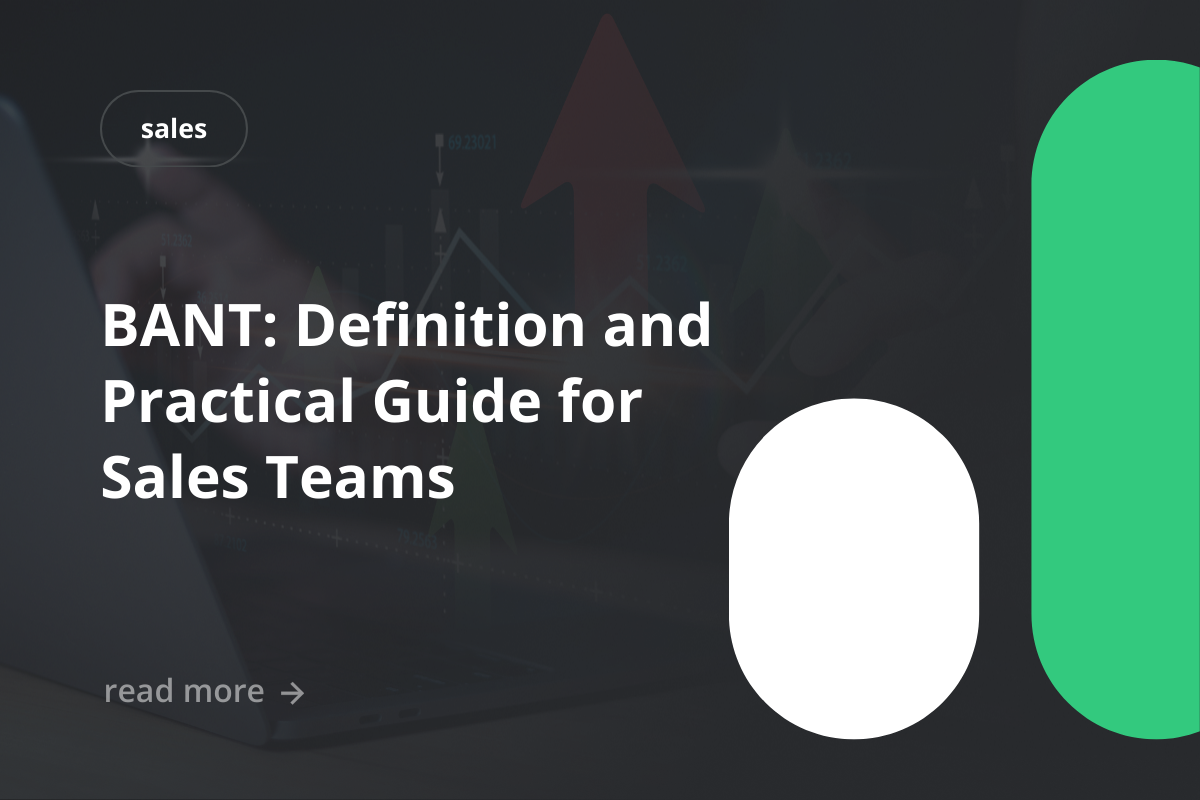BANT: Definition and Importance
In this article, we’ll take a closer look at BANT definition, why it’s important, and how you can use it to qualify leads more effectively and boost your sales success.
What is the BANT Definition?
BANT is an acronym standing for Budget, Authority, Need, and Timing. It is a sales qualification framework that helps sales teams identify and prioritize potential leads. By evaluating these four key criteria, sales professionals can determine whether a prospect is a good fit for their products or services. BANT not only streamlines the sales process but also enhances the likelihood of closing deals, guiding sales representatives to focus their efforts on leads that show the most promise.
Why BANT is Crucial for Sales Teams
BANT is crucial for sales teams because it provides a structured approach to lead qualification. By using this method, sales representatives can efficiently allocate their time and resources on high-potential prospects. Moreover, BANT fosters alignment within the sales team regarding what constitutes a qualified lead, enabling them to work in synergy toward closing sales. This standardized framework minimizes the risks associated with pursuing non-ideal leads, ultimately boosting sales productivity and outcomes.
The BANT Sales Process Unpacked

Step-by-Step Guide to Implementing BANT
Implementing BANT revolves around a systematic approach:
- Budget: Assess whether the prospect has the financial resources to invest in your solution.
- Authority: Identify if you are communicating with the decision-maker or need to involve other stakeholders.
- Need: Understand the specific challenges or requirements of the prospect that your offering can address.
- Timing: Determine the urgency of the prospect’s need and their timeline for making a decision.
This step-by-step qualification allows for a focused conversation tailored to the prospect’s unique situation.
Common Pitfalls in the BANT Sales Process
Despite its effectiveness, there are common pitfalls when using the BANT methodology.
- One significant issue is failing to dig deeply enough into each category, leading to superficial assessments that can misguide sales efforts.
- Additionally, rigid adherence to BANT without flexibility can result in missed opportunities, as not all prospects fit neatly into predefined categories.
- Finally, neglecting to regularly revisit and update the information gathered can lead to a misalignment with the prospect’s evolving needs.
Measuring Success with the BANT Method
To measure success with the BANT method, sales teams should track metrics such as conversion rates of qualified leads to sales and the length of the sales cycle. Analyzing feedback on how many leads progressed through each BANT category can also provide insights into the effectiveness of the qualification process. Regular team reviews and adjustments based on performance data can help fine-tune methodologies, ensuring continuous improvement in qualifying leads.
Implementing BANT for B2B Sales

Adapting BANT to the B2B Environment
Adapting BANT for the B2B environment requires a tailored approach due to the complexity of business relationships. In B2B sales, the buying process often involves multiple stakeholders and longer decision cycles. Sales teams must ensure that they engage with all relevant decision-makers and their specific budget constraints. Additionally, understanding organizational needs and timelines can help create a more cohesive sales strategy that addresses the common hurdles in B2B transactions.
Examples of BANT in B2B Sales Scenarios
In a B2B sales scenario, a software company might first assess if a business has allocated sufficient budget for a new platform (Budget), then determine whether the IT manager or C-suite executive is involved in decision-making (Authority). Next, uncovering specific pain points like inefficiency in current software leads to understanding their Need, while clarifying the urgency of their digital transformation plans aids in establishing their Timing. By effectively applying BANT in these scenarios, sales teams can optimize their outreach and conversions.
Challenges in Using BANT for B2B
Challenges in utilizing BANT for B2B sales include the difficulty in accurately identifying decision-makers in larger organizations, as well as varying budgets and timing influenced by other departments. Additionally, navigating the often bureaucratic nature of B2B purchases can slow down the sales process, requiring patience and adaptability. Sales teams might also struggle with collecting complete and accurate information, impacting the efficacy of their approach to qualification.
BANT for Startups: A Practical Approach

Tailoring BANT for Early Stage Businesses
For startups, tailoring BANT emphasizes agility and resourcefulness. Startups often face budget constraints and must prioritize leads that promise the highest value. By quickly understanding which prospects have the authority to make decisions, recognizing their needs, and establishing a clear timeline for product adoption, startups can efficiently nurture relationships. Flexibility in adapting BANT processes to changing priorities in the early stages is key to sustaining momentum.
Tips for Startups to Master BANT
To master BANT, startups should focus on thorough research and preparation before engaging prospects. Leveraging tools like CRM software can help track insights about leads effectively. Additionally, building relationships through networking can help identify budgeting and authority issues early on. Startups should also remain open to feedback and be ready to pivot their strategy based on market responses to enhance their approach to qualification.
BANT Definition and FAQ
What is the BANT definition in sales?
BANT in sales is a method for qualifying leads based on their Budget, Authority, Need, and Timing, allowing sales teams to focus on the most promising prospects.
How does BANT improve sales performance?
BANT improves sales performance by providing a structured framework for lead qualification, ensuring that sales efforts are concentrated on high-potential leads and increasing the efficiency of the sales process.
Can BANT be integrated with other sales methodologies?
Yes, BANT can be integrated with other sales methodologies, such as SPIN selling or Challenger sales, to create a more comprehensive approach to qualifying leads and managing the sales process.
What are the main benefits of the BANT method?
The main benefits of the BANT method include improved lead qualification, optimized sales cycles, increased conversion rates, and enhanced clarity within sales teams regarding prospect qualifications.
Is BANT suitable for all types of sales?
While BANT is versatile and widely applicable, it is particularly well-suited for B2B and enterprise sales where funding, authority, need, and timing play crucial roles. It may require adaptations in more transactional or consumer-focused sales environments.



